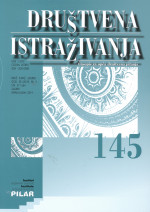Self-Evaluated ADHD Symptoms as Risk Adaptation Factors in Elementary School Children
Self-Evaluated ADHD Symptoms as Risk Adaptation Factors in Elementary School Children
Author(s): Zvonimir UŽAREVIĆ, Tena Velki, Snježana DUBOVICKISubject(s): School education, Psychology of Self, Behaviorism
Published by: Institut društvenih znanosti Ivo Pilar
Keywords: hyperactivity; impulsiveness; inattention; academic adjustment; social adjustment; emotional adjustment;
Summary/Abstract: Previous studies have shown that students with ADHD symptoms are more likely to have problems in all aspects of adaptation. The aim of this study is to identify ADHD symptoms that predict maladjustment in the general population of students. Hyperactivity, impulsiveness and inattention were examined with respect to academic, social and emotional adjustment. Elementary school students (average age M = 12.72, SD = 1.62) participated in the study (N = 501). The instruments used were: Hyperactivity-Impulsivity-Attention Scale, Croatian version of Self-efficacy questionnaire for children, Emotional competence questionnaire, self-assessment of peer acceptance and school success. Inattention was a significant predictor of problems in all aspects of adaptation, i.e. academic (β = -0.317; β = -0.528; p < 0.001), social (β = -0.269; β = -0.430; p < 0.001) and emotional adjustment (β = -0.225; β = -0.367; p < 0.01). Impulsiveness was only a significant predictor of academic self-efficacy (β = -0.187, p < 0.01), whereas hyperactivity was only significant for emotional competence (β = -0.174, p < 0.05). Since inattention proved to be a dominant problem, it is recommended that experts working with children make an effort to increase attention and concentration as a prevention strategy for adaptation problems of all students.
Journal: Društvena istraživanja - Časopis za opća društvena pitanja
- Issue Year: 28/2019
- Issue No: 3
- Page Range: 503-522
- Page Count: 20
- Language: English

